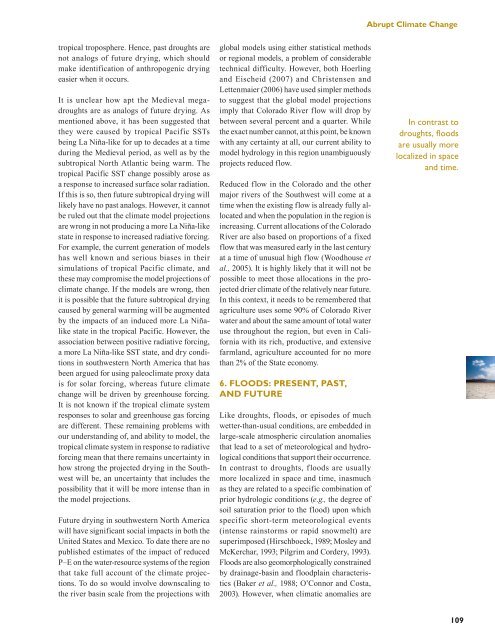Book 2.indb - US Climate Change Science Program
Book 2.indb - US Climate Change Science Program
Book 2.indb - US Climate Change Science Program
- No tags were found...
You also want an ePaper? Increase the reach of your titles
YUMPU automatically turns print PDFs into web optimized ePapers that Google loves.
Abrupt <strong>Climate</strong> <strong>Change</strong>tropical troposphere. Hence, past droughts arenot analogs of future drying, which shouldmake identification of anthropogenic dryingeasier when it occurs.It is unclear how apt the Medieval megadroughtsare as analogs of future drying. Asmentioned above, it has been suggested thatthey were caused by tropical Pacific SSTsbeing La Niña-like for up to decades at a timeduring the Medieval period, as well as by thesubtropical North Atlantic being warm. Thetropical Pacific SST change possibly arose asa response to increased surface solar radiation.If this is so, then future subtropical drying willlikely have no past analogs. However, it cannotbe ruled out that the climate model projectionsare wrong in not producing a more La Niña-likestate in response to increased radiative forcing.For example, the current generation of modelshas well known and serious biases in theirsimulations of tropical Pacific climate, andthese may compromise the model projections ofclimate change. If the models are wrong, thenit is possible that the future subtropical dryingcaused by general warming will be augmentedby the impacts of an induced more La Niñalikestate in the tropical Pacific. However, theassociation between positive radiative forcing,a more La Niña-like SST state, and dry conditionsin southwestern North America that hasbeen argued for using paleoclimate proxy datais for solar forcing, whereas future climatechange will be driven by greenhouse forcing.It is not known if the tropical climate systemresponses to solar and greenhouse gas forcingare different. These remaining problems withour understanding of, and ability to model, thetropical climate system in response to radiativeforcing mean that there remains uncertainty inhow strong the projected drying in the Southwestwill be, an uncertainty that includes thepossibility that it will be more intense than inthe model projections.Future drying in southwestern North Americawill have significant social impacts in both theUnited States and Mexico. To date there are nopublished estimates of the impact of reducedP–E on the water-resource systems of the regionthat take full account of the climate projections.To do so would involve downscaling tothe river basin scale from the projections withglobal models using either statistical methodsor regional models, a problem of considerabletechnical difficulty. However, both Hoerlingand Eischeid (2007) and Christensen andLettenmaier (2006) have used simpler methodsto suggest that the global model projectionsimply that Colorado River flow will drop bybetween several percent and a quarter. Whilethe exact number cannot, at this point, be knownwith any certainty at all, our current ability tomodel hydrology in this region unambiguouslyprojects reduced flow.Reduced flow in the Colorado and the othermajor rivers of the Southwest will come at atime when the existing flow is already fully allocatedand when the population in the region isincreasing. Current allocations of the ColoradoRiver are also based on proportions of a fixedflow that was measured early in the last centuryat a time of unusual high flow (Woodhouse etal., 2005). It is highly likely that it will not bepossible to meet those allocations in the projecteddrier climate of the relatively near future.In this context, it needs to be remembered thatagriculture uses some 90% of Colorado Riverwater and about the same amount of total wateruse throughout the region, but even in Californiawith its rich, productive, and extensivefarmland, agriculture accounted for no morethan 2% of the State economy.6. Floods: Present, Past,and FutureLike droughts, floods, or episodes of muchwetter-than-usual conditions, are embedded inlarge-scale atmospheric circulation anomaliesthat lead to a set of meteorological and hydrologicalconditions that support their occurrence.In contrast to droughts, floods are usuallymore localized in space and time, inasmuchas they are related to a specific combination ofprior hydrologic conditions (e.g., the degree ofsoil saturation prior to the flood) upon whichspecific short-term meteorological events(intense rainstorms or rapid snowmelt) aresuperimposed (Hirschboeck, 1989; Mosley andMcKerchar, 1993; Pilgrim and Cordery, 1993).Floods are also geomorphologically constrainedby drainage-basin and floodplain characteristics(Baker et al., 1988; O’Connor and Costa,2003). However, when climatic anomalies areIn contrast todroughts, floodsare usually morelocalized in spaceand time.109






